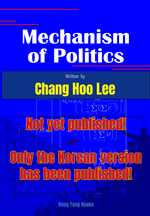Chapter 0. Contents of this
book
(1) Optimization of Theory

There can be several ways to systematize
a theory. I aim to construct an "optimized theoretical
system" that follows the model of geometry among
various methods. I will explain in detail what it
means.
Traditionally, in the scientific
field, the system of geometry was considered as a
model of systematic knowledge. As seen in the history
of mathematics where efforts were made to eliminate
the Euclidean geometry's fifth axiom, a theoretical
system strives to explain as many phenomena as possible
with the least number of concepts and general laws.
The worst scenario is to explain each phenomenon with
its own law, which is like explaining 10 cases with
10 laws. This cannot be considered an explanation.
This is close to the politics of the 20th century.
Then, what is the theoretical system
of geometry like? The theoretical system of geometry,
also known as the "axiomatic system", starts
with simple and clear concepts and builds up complex
laws by aligning the transparent laws expressed by
these concepts. "Aligning" means logically
deducing. This book attempts to pursue a theory of
political phenomenon in a similar manner.
First, it starts with simple and
clear concepts. As you read through this book, for
example, by comparing my explanation of concepts such
as organization or power with the explanations of
the other political scientists, you will see what
it means for concepts to be simple and clear. I describe
organization as a group of people combined by a rule
system, while other political scientists explain it
with complex and sophisticated expressions that almost
seem literary. People who like theoretical theories
may be fascinated by such explanations, but with such
concepts, general laws cannot be established.
Second, it is necessary to establish
simple and self-evident general laws through simple
concepts. The laws that answer the question "Why?"
for complex and changing phenomena should be based
on concepts that are easily accepted and taken for
granted.
I have presented three laws of political
phenomena based on these general laws. The contents
are experientially valid and self-evident when understood
the meaning of each law. So, the contents of this
book may not be particularly outstanding and may feel
like a repetitive iteration of what everyone already
knows. So the contents of this book may not be particularly
outstanding and may feel repetitive with already known
information. The novelty of this book lies in selecting
the minimum number of laws that can be used to explain
all political phenomena among the "common"
laws and arranging them accordingly.
Therefore, the content of this book,
which attempted to establish an optimized theoretical
system to explain political phenomena, is not about
new or developing directions in politics, but rather
contains an organized and systematic way of understanding
political phenomena. It is a scientific political
theory, different from literary or philosophical political
theories.
  
|